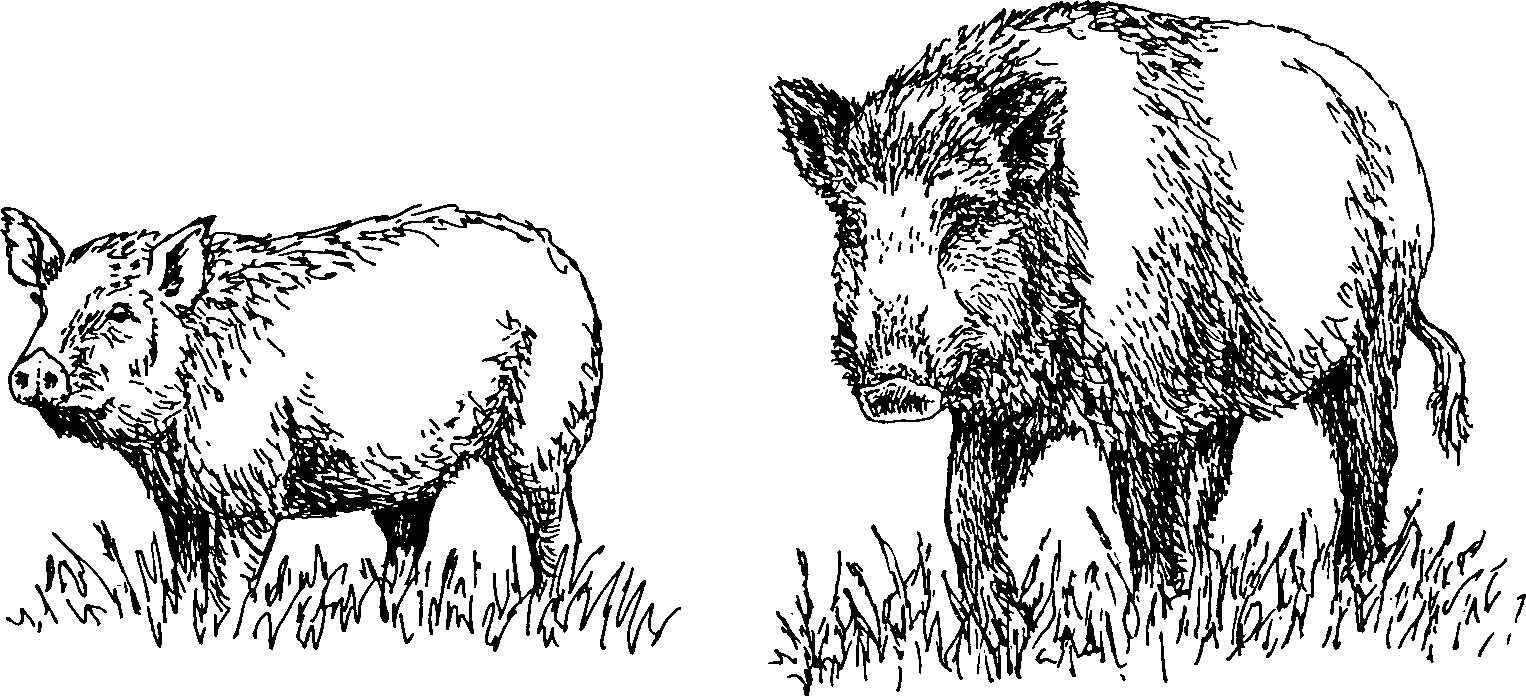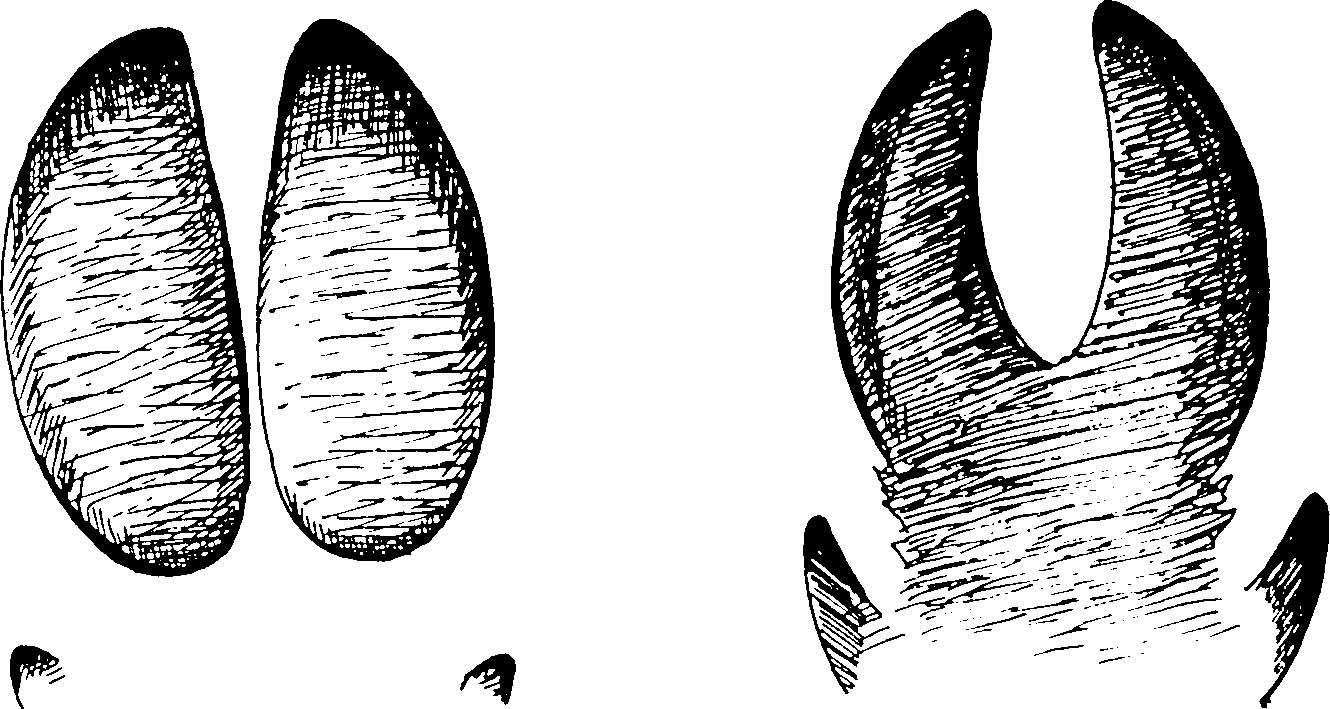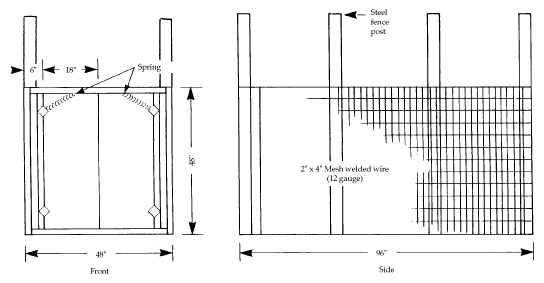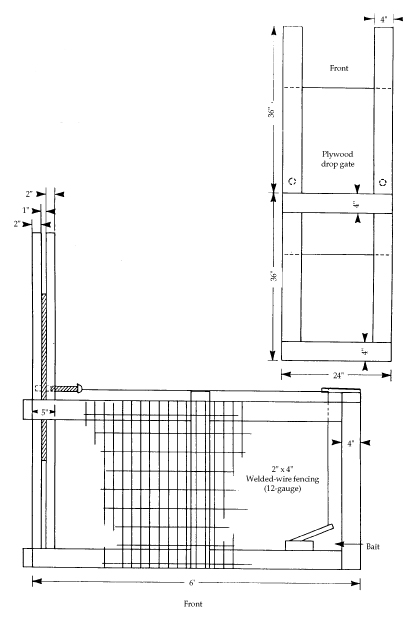|
|
|
|
 |
OTHER MAMMALS: Wild Pigs |
|
|

Fig. 1. Feral hog (left)
and European wild boar (right). Both are the species,
Sus scrofa.
Identification
Wild pigs (Sus scrofa,
Fig. 1) include both feral hogs (domestic swine that
have escaped captivity) and wild boar, native to Eurasia
but introduced to North America to interbreed with feral
hogs. Like domestic hogs, they may be any color. Their
size and conformation depend on the breed, degree of
hybridization with wild boar, and level of nutrition
during their growing period.
Wild boar have longer legs
and larger heads with longer snouts than feral hogs. The
color of young boar is generally reddish brown with
black longitudinal “watermelon” stripes. As the young
develop, the stripes begin to disappear and the red
changes to brown and finally to black. Both the male
feral hog and wild boar have continuously growing tusks.
Wild boar and feral hogs hybridize freely; therefore,
the term wild pig is appropriate as a generic term for
these animals.
Range
Christopher Columbus first
introduced members of the family Suidae into North
America in 1493 in the West Indies (Towne and Wentworth
1950). The first documented introduction to the United
States was in Florida by de Soto in 1593. More
introductions followed in Georgia and the Carolinas,
which established free-ranging populations in the
Southeast. Free-ranging practices continued until they
became illegal in the mid-twentieth century. Populations
of unclaimed hogs increased and spread throughout the
Southeast. Domestic hogs were released in California in
1769 and free-ranging practices there also resulted in a
feral hog population. European wild boar were released
at Hooper Bald, North Carolina, in 1912, and from there
introduced to California in 1925.
Wild pigs are found
throughout the southeastern United States from Texas
east to Florida and north to Virginia; and in
California, Hawaii, Puerto Rico, and the Virgin Islands.
The local introduction of these animals for hunting
purposes occurred in North Carolina, Tennessee, Texas,
Louisiana, and California. The National Park Service
reports feral hogs in 13 National Park Service areas.
They occur in many state parks as well (Mayer and
Brisbin 1991). Feral hogs are also found in Hawaii,
Australia, New Zealand, and several other South Pacific
Islands.
Habitat
A variety of habitats,
from tidal marshes to mountain ranges, are suitable for
wild pigs. They prefer cover of dense brush or marsh
vegetation. They are generally restricted to areas below
snowline and above freezing temperatures during the
winter. Wild pigs frequent livestock-producing areas.
They prefer mast-producing hardwood forests but will
frequent conifer forests as well. In remote areas or
where human activities are minimal, they may use open
range or pastures, particularly at night. During periods
of hot weather, wild pigs spend a good deal of time
wallowing in ponds, springs, or streams, usually in or
adjacent to cover.
Food Habits
Types of food vary greatly
depending on the location and time of year. Wild pigs
will eat anything from grain to carrion. They may feed
on underground vegetation during periods of wet weather
or in areas near streams and underground springs. Acorns
or other mast, when available, make up a good portion of
their diet. Wild pigs gather in oak forests when acorns
fall, and their movements will generally not be as great
during this period. In the winters of poor mast years,
wild pigs greatly increase their range and consume
greater quantities of underground plant material,
herbaceous plants, and invertebrates (Singer 1981).
Stomach analyses indicate that wild hogs ingest flesh
from vertebrates, but the extent to which animals are
taken as prey or carrion is not known. Wild pigs are
capable of preying on lambs (Pavlov et al. 1981), as
well as goat kids, calves, and exotic game.
General Biology, Reproduction, and Behavior
Wild pigs are intelligent
animals and readily adapt to changing conditions. They
may modify their response to humans fairly rapidly if it
benefits their survival. Wild boar have a greater
capacity to invade colder and more mountainous terrain
than do other wild pigs. Feral hogs feed during daylight
hours or at night, but if hunting pressure becomes too
great during the day, they will remain in heavy cover at
that time and feed at night. In periods of hot weather,
wild pigs remain in the shade in wallows during the day
and feed at night.
The wild pig is the most
prolific large wild mammal in North America. Given
adequate nutrition, a wild pig population can double in
just 4 months. Feral hogs may begin to breed before 6
months of age, if they have a high-quality diet. Sows
can produce 2 litters per year and young may be born at
any time of the year. Wild boar usually do not breed
until 18 months of age and commonly have only 1 litter
per year unless forage conditions are excellent. Like
domestic animals, the litter size depends upon the sow’s
age, nutritional intake, and the time of year. Litter
sizes of feral hogs in northern California average 5 to
6 per sow (Barrett 1978). Wild boar usually have litter
sizes of 4 to 5 but may have as many as 13 (Pine and
Gerdes 1973).
Damage
and Damage Identification
Wild pigs can cause a
variety of damage. The most common complaint is rooting
(sometimes called grubbing), resulting in the
destruction of crops and pastures. Damage to farm ponds
and watering holes for livestock is another common
problem. Predation on domestic stock and wildlife has
been a lesser problem in North America.
Damage to crops and
rangeland by wild pigs is easily identified. Rooting in
wet or irrigated soil is generally quite visible, but
can vary from an area of several hundred square feet
(m2) or more to only a few small spots where the ground
has been turned over. Rooting destroys pasture, crops,
and native plants, and can cause soil erosion. Wallows
are easily seen around ponds and streams. Tracks of
adult hogs resemble those made by a 200pound (90-kg)
calf. Where ground is soft, dewclaws will show on adult
hog tracks (Fig. 2).

Fig. 2. Tracks of the feral hog (left) and European wild
boar (right).
Wild pig depredation on
certain forest tree seedlings has been a concern of
foresters in the South and West. Wild pigs have
destroyed fragile plant communities in Great Smoky
Mountains National Park and other preserves. They have
been known to damage fences when going into gardens and
can do considerable damage to a lawn or golf course in a
single night.
In California, wild pigs
have entered turkey pens, damaging feeders, eating the
turkey feed, and allowing birds to escape through
damaged fences. Wild pigs in New South Wales, Australia,
reportedly killed and ate lambs on lambing grounds.
Producers in Texas and California reported to
USDA-APHIS-ADC that 1,473 sheep, goats, and exotic game
animals were killed by wild pigs in 1991. Predation
usually occurs on lambing or calving grounds, and some
hogs become highly efficient predators. Depredation to
calves and lambs can be difficult to identify because
these small animals may be killed and completely
consumed, leaving little or no evidence to determine
whether they were killed or died of other causes and
then were eaten. Determining predation by wild hogs is
possible if carcasses are not entirely eaten, because
feral hogs follow a characteristic feeding pattern on
lambs (Pavlov and Hone 1982). Photographs and additional
information on wild pig predation may be found in the
booklet by Wade and Bowns (1982).
Always be aware of the
potential for disease transmission when feral hogs are
associated with domestic livestock. Cholera, swine
brucellosis, trichinosis, bovine tuberculosis, foot and
mouth disease, African swine fever, and pseudorabies are
all diseases that may be transmitted to livestock (Wood
and Barrett 1979). Bovine tuberculosis was transmitted
to beef cattle by wild hogs on the Hearst Ranch in
California in 1965. Pork that was infected with hog
cholera brought into Kosrae Island in the East Carolinas
resulted in the decimation of all domestic and feral
hogs on the island.
Legal Status
Wild pigs are game mammals
in California, Texas, Tennessee, North Carolina, Puerto
Rico, Hawaii, and Florida (Wood and Barrett 1979, Mayer
and Brisbin 1991). In California, a depredation permit
is required from the Department of Fish and Game to
conduct a control program or to take depredating
animals. Contact your state wildlife agency to determine
if a permit is required.
Damage Prevention and Control Methods
Exclusion
Fencing is generally not practical except in small areas
around yards and gardens. Heavy wire and posts must be
used, but if hogs are persistent, exclusion is almost
impossible. Electric fencing on the outside of the mesh
may be of some help, but it is difficult to maintain
over large areas. Electric fencing has been used
effectively in New South Wales, Australia. See the Deer
chapter for details on electric fencing.
Frightening No
methods are effective.
Repellents None are
registered.
Toxicants There are
no toxicants currently registered for controlling wild
pigs in the United States.
Trapping
Cage Traps. Trapping, especially where pig densities
are high, is probably the most effective control method.
Traps may not be effective, however, during fall and
winter when acorns or other preferred natural foods are
available. Hogs seem to prefer acorns over grain and
other baits. Leg snares and hunting may be more
productive control methods during fall and winter.
Stationary corral-type traps and box traps have been
used with success. The corral or stationary trap is
permanent and should be constructed in locations where
large populations of hogs are evident and where more
than one hog can be trapped at a time (Fig. 3). Build
the trap out of steel fence posts and 2 x 4-inch (5.1 x
10.2-cm) welded 12-gauge wire fencing. A gate frame can
be made from 2 x 4-inch (5.1 x 10.2-cm) boards. Make
doors from 3/4-inch (1.9-cm) plywood and mount them so
that they open inward and close automatically with
screen door springs. Heavier material may be used for
the gate and frame in areas where exceptionally large
hogs are to be trapped. Also, more steel fence posts may
be needed to reinforce the wire fencing. The wire
fencing should be put on the ground as well as at the
top of the trap to prevent hogs from going under the
sides or over the top. Fasten the sides to the top and
bottom. One or two small hogs can be left inside the
trap with adequate food and water to act as decoys.
A portable trap with a
drop gate has been used very effectively and can be
moved from one area to another (Fig. 4). It is
especially effective where hogs occur intermittently.
Build the trap out of 2 x 4-inch (5.1 x 10.2-cm) welded
12-gauge wire over a 2 x 4-inch (5.1 x 10.2-cm) wooden
frame using a 3/4-inch (1.9-cm) plywood drop gate. Place
loose barbed wire fencing around the outside of the trap
to prevent livestock from entering and to protect both
the traps and bait material. When traps are not in use
make sure trap doors are locked shut to prevent the
possibility of trapping livestock.
There are a number of
different styles of live or cage traps. The two
described here have been used effectively in California.
As many as 14 hogs have been trapped during a night in
one trap. It is important that the material used in the
construction of these traps be strong and heavy enough
to prevent escapes. Corral-type traps have captured up
to 104 hogs in a single night and may have to be
reinforced with extra fence posts and heavier fencing
material.
Fig. 3. Stationary hog
trap.

2" x 4" x 24' wood
36" x 48" x 3/4" plywood
36' x 2" x 4" mesh welded wire
4 6" strap hinges
2 12" screen door springs
8 6" steel fence posts 4 lbs.
16-penny nails 1 lb.
12-penny nails 2 lbs.
1 1/2" staples 1
100' 12-gauge wire
Persistence and dedication
are required if a feral hog control program is to be
successful. Traps must be checked daily to be reset and
to replace bait when needed. Many times control measures
fail because operators fail to check their traps or
provide bait in adequate amounts. Trapping hogs that are
feeding on acorns may be difficult because they seem to
prefer acorns to grain or other baits.
Traps should be checked
from a distance when possible. If several large hogs are
in a trap, the presence of a person or vehicle will
frighten them and escapes can occur even out of
well-built traps. A well-placed shot to the head from a
large-caliber rifle will kill the hog instantly without
greatly alarming other hogs in the trap. Shoot the
largest hog first, if possible. When a trapping program
is being conducted, all hunting in the area should
cease, especially the use of dogs, as this may pressure
the pigs to move to another area.
A prebaiting program
should be conducted before a trapping program is
initiated. Grains such as barley, corn, or oats make
good attractants, as do vegetables or fruits, if a
supply is available. If bait is accepted by hogs,
replace it daily. Make sure enough bait is out to induce
hogs to return the next day; if no feed is available,
they may move on to other feeding areas. A place where
hogs have gathered in the past and seem to frequent
often, is probably a good place to build a cor-ral-type
trap. If only one or two hogs are attracted to the
prebait, a portable trap should be installed.
Fig. 4. Portable hog trap
with drop gate

8 2" x 4" x 6'
4 2" x 4" x 3'
6 2" x 4" x 2'
1 3/4" x 24" x 36" plywood
2 3' x 6' welded-wire fencing (12-gauge)
2 2' x 6' welded-wire fencing (12-gauge)
1 2' x 3' welded-wire fencing (12-gauge)
2 3" strap hinges
1 12" x 20" plywood
2 8' cable or nylon
2 1" x 1" steel pin
16-penny nails
If a swing gate corral
trap is prebaited, prop the doors open so that hogs can
move in and out. When it appears that the number of hogs
that are accepting the bait has peaked, position the
doors so that they will close after hogs enter the trap.
Steel Traps. Steel
leghold traps are not recommended for pigs.
Leg Snares Leg
snares can be used with success where terrain prohibits
the use of cage traps. Snares are not recommended if
livestock, deer, or other nontarget animals are in the
area. An ideal location for leg snares is at a fence
where hogs are entering pens or on trails that hogs are
traveling. Fasten the snare to a heavy drag, such as an
oak limb, 6 to 12 feet (1.8 to 3.6 m) in length, or
longer if large hogs are in the area. Make sure the size
of the cable is heavy enough to hold a large hog.
Shooting
Sport hunting is used in certain areas to reduce
wild pig densities and can be a source of revenue for
ranchers. Success is highly dependent on local
situations and terrain. Hunting is not recommended if
there is a serious depredation or disease problem.
Unsuccessful hunting will make wild pigs keep to cover
and change their feeding habits. The use of dogs can
increase hunter success. Good dogs chase pigs from cover
where they can be shot by hunters.
Economics of Damage and Control
In most areas it is
unlikely that wild pigs can be exterminated. It is
theoretically possible, but the cost to do so is usually
prohibitive. Landowners must generally accept the fact
that they will always have some wild pigs and should
therefore plan for a long-term control program.
Feral hog damage can be
extensive and costly if not controlled. Control for
disease suppression is extremely expensive because many
hogs need to be eliminated. Crop depredations may cease
after one or two hogs are shot or trapped, or
intermittent hunting pressure is put on them. They
simply move to new areas. If depredations are heavy
enough to require a reduction in the overall population
then a program can be very costly, depending on the size
of the area involved.
Acknowledgments
Figures 1 and 2 by Emily
Oseas Routman.
Figures 3 and 4 by Marilyn
Murtos, US Bureau of Reclamation, Sacramento,
California.
For Additional Information
Barrett, R. H. 1970.
Management of feral hogs on private lands. Trans.
Western Sect. Wildl. Soc. 6:71-78.
Barrett, R. H. 1977. Wild
pigs in California. Pages 111-113 in G. W. Wood, ed.
Research and management of wild hog populations. Symp.
Belle W. Baruch For. Sci. Inst., Clemson Univ.,
Georgetown, South Carolina.
Barrett, R. H. 1978. The
feral hog on the Dye Creek Ranch, California. Hilgardia
46:283-355.
Barrett, R. H., B. L.
Goatcher, P. J. Gogan, and E.
L. Fitzhugh. 1988.
Removing feral pigs from Annadel State Park. Trans.
Western Sect. Wildl. Soc. 24:47-52.
Bratton, S. P. 1974. The
effect of the European wild boar (Sus scrofa) on the
high elevation vernal flora in Great Smoky Mountains
National Park. Bull. Torrey Bot. Club 101:198-206.
Mayer, J. J., and I. L.
Brisbin, Jr. 1991. Wild pigs of the United States: their
history, morphology, and current status. Univ. Press,
Athens, Georgia. 313 pp.
Pavlov, P. M., and J.
Hone. 1982. The behavior of feral pigs, Sus scrofa, in a
flock of lambing ewes. Australian Wildl. Resour.
9:101-109.
Pavlov, P. M., J. Hone, R.
J. Kilgour, and H. Pedersen. 1981. Predation by feral
pigs on Merino lambs at Nyngan, New South Wales.
Australian J. Exp. Agric. An. Husb. 21:570-574.
Pine, D. S., and C. S.
Gerdes. 1973. Wild pigs in Monterey county, California.
California Fish Game 59:126-137.
Plant, J. W. 1977. Feral
pigs predators of lambs. Agric. Gazette, New South Wales
Dep. Agric. Vol. 8, No.5.
Plant, J. W. 1980.
Electric fences give pigs a shock. Agric. Gazette, New
South Wales Dep. Agric. Vol. 91, No. 2.
Singer, F. J. 1981. Wild
pig populations in the national parks. Environ. Manage.
5:263-270.
Singer, F. J., D. K. Otto,
A. R. Tipton, and C. P. Hable. 1981. Home range
movements and habitat use of wild boar. J. Wildl.
Manage. 45:343-353.
Sterner, J. D., and R. H.
Barrett. 1991. Removing feral pigs from Santa Cruz
Island, California. Trans. Western Sect. The Wildl. Soc.
27:47-53.
Tisdell, C. A. 1982. Wild
pigs: environmental pest or economic resource? Pergamon
Press, New York. 445 pp.
Towne, C. W., and E. N.
Wentworth. 1950. Pigs from Cave to Cornbelt. Univ.
Oklahoma Press, Norman. 305 pp.
Wade, D. A., and J. E.
Bowns. 1982. Procedures for evaluating predation on
livestock and wildlife. Bull. B-1429, Texas A & M Univ.,
College Station. 42 pp.
Wood, C. W., and R.
Barrett. 1979. Status of wild pigs in the United States.
Wildl. Soc. Bull. 7:237-246.
Editors
Scott E. Hygnstrom Robert
M. Timm Gary E. Larson
PREVENTION AND CONTROL OF
WILDLIFE DAMAGE — 1994
Cooperative Extension
Division Institute of Agriculture and Natural Resources
University of Nebraska -Lincoln
United States Department
of Agriculture Animal and Plant Health Inspection
Service Animal Damage Control
Great Plains Agricultural
Council Wildlife Committee
Special
thanks to:
Clemson University
|